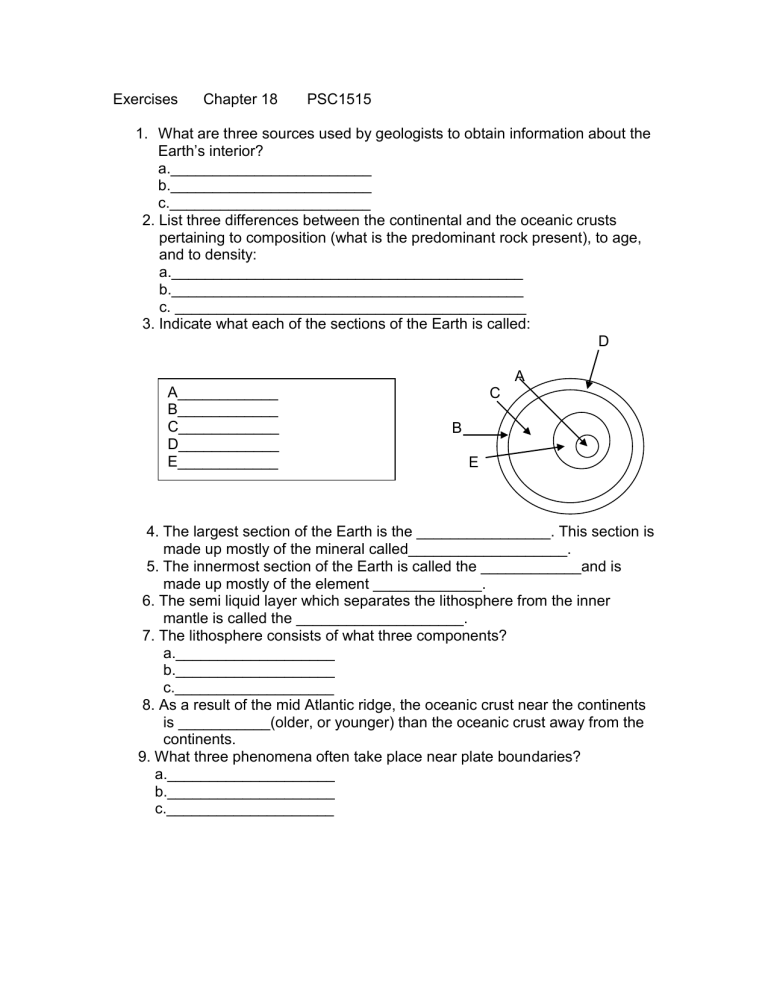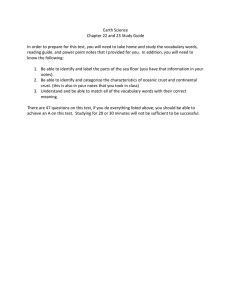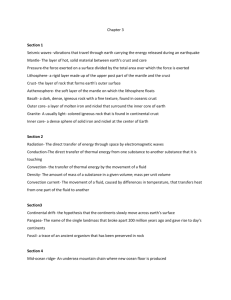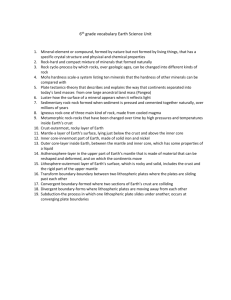Exercises Chapter 18 ... 1. What are three sources used by geologists to...

Exercises Chapter 18 PSC1515
1. What are three sources used by geologists to obtain information about the
Earth’s interior? a.________________________ b.________________________ c.________________________
2. List three differences between the continental and the oceanic crusts
pertaining to composition (what is the predominant rock present), to age,
and to density:
a.__________________________________________
b.__________________________________________
c. __________________________________________
3. Indicate what each of the sections of the Earth is called:
D
A
B____________
D____________
4. The largest section of the Earth is the ________________. This section is
made up mostly of the mineral called___________________.
5. The innermost section of the Earth is called the ____________and is
made up mostly of the element _____________.
6. The semi liquid layer which separates the lithosphere from the inner
mantle is called the ____________________.
7. The lithosphere consists of what three components?
a.___________________
b.___________________
c.___________________
8. As a result of the mid Atlantic ridge, the oceanic crust near the continents
is ___________(older, or younger) than the oceanic crust away from the
continents.
9. What three phenomena often take place near plate boundaries?
a.____________________
b.____________________
c.____________________
10. Match the plate boundary that applies to each of the following:
Divergent Plates (DP) ___Plates that slide past each other
Convergent Plates (CP) ___Can result in subduction zones
Transform Boundaries (TB) ___New crust is created
___Crust is eliminated
___Led to the Andes Mountains
___Iceland is a result of it
___ Japan is a result of it
___Earthquakes in San Andreas fault is a
result of it.
___Plates come together closer
___Plates separate from each other
___The Red Sea resulted from it.
___The Mid Atlantic ridge is on it.
11. Plate boundaries can be continent-continent (CC), ocean-ocean (OO), or
continent-ocean (CO). Identify which plate boundary is present for each of
the following:
____a. The Himalayas
____b. The Andes
____c. The San Andreas Fault
____d. The Japanese Islands
Answers:
1. Seismic studies, meteorite composition, magma from volcanoes.
2. Continental crust is older, less dense and made up mostly of granite.
Oceanic crust is younger, denser, and made up mostly of basalt.
3. Inner Core, Moho, mantle, crust, outer core.
4. mantle, olivine 5. core, iron 6. asthenosphere
7. the crust, the moho and the upper mantle.
8. older 9. vocanoes, earthquakes, mountains
10. TB, CP, DP, CP, CP, DP, CP, TB, CP, DP, DP, DP
11. CC, CO, CO, OO








